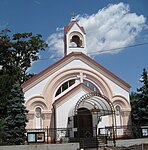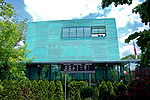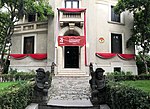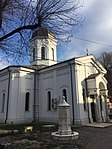Monument to the Heroes of the Air

The Monument to the Heroes of the Air (Romanian: Monumentul Eroilor Aerului), located in the Aviators' Square, on Aviators' Boulevard, Bucharest, Romania, was built between 1930 and 1935 by sculptors Lidia Kotzebue (1885–1944), and by Iosif Fekete. The structure, 20 m (65.6 ft) high, is made up of bronze sculptures resting on an obelisk-shaped stone pedestal, which in turn stands atop four trapezoidal prisms linked to each other by arcs. Beneath this entire complex is a circular stone base. Attached to the top of the obelisk, which reaches 15 m, is a 5-meter, 5-ton statue depicting a flying man, his wings outstretched. The folds of a shawl fall from his waist onto the obelisk. Three aviators, each in a different stage of flight attempt, are depicted around the base of the obelisk. On the pedestal are the aviators' insignia, helmet and equipment, as well as engraved plaques with the names of Romanian airmen who had crashed to their deaths by the time the monument was built. These men died pursuing various goals: skill development, performance, adventure and fighting in World War I. The first name is that of Gheorghe Caranda, killed on 20 April 1912 on an airfield during a training flight; the last is that of Sava Rotaru, killed on 29 May 1934 in thick fog in the hills around Cernavodă. After the official dedication, 99 additional names have been posted on the North bottom side of the pedestal.
Excerpt from the Wikipedia article Monument to the Heroes of the Air (License: CC BY-SA 3.0, Authors, Images).Monument to the Heroes of the Air
Strada Arhitect Ion Mincu, Bucharest Aviatorilor (Sector 1)
Geographical coordinates (GPS) Address External links Nearby Places Show on map
Geographical coordinates (GPS)
| Latitude | Longitude |
|---|---|
| N 44.45976 ° | E 26.08609 ° |
Address
Monumentul Aviatorilor
Strada Arhitect Ion Mincu
011852 Bucharest, Aviatorilor (Sector 1)
Romania
Open on Google Maps










